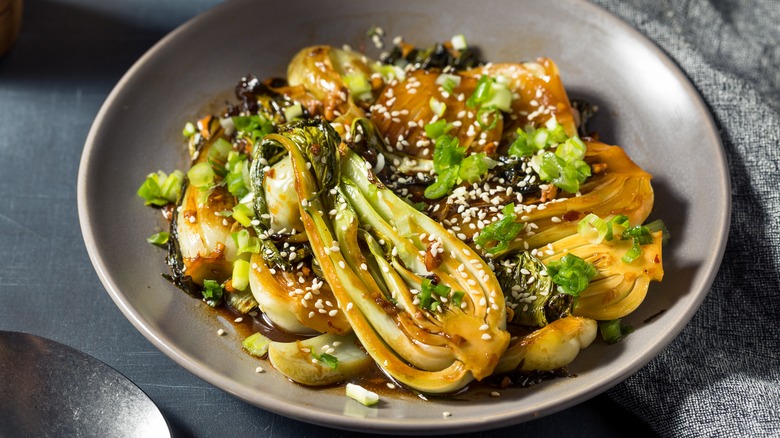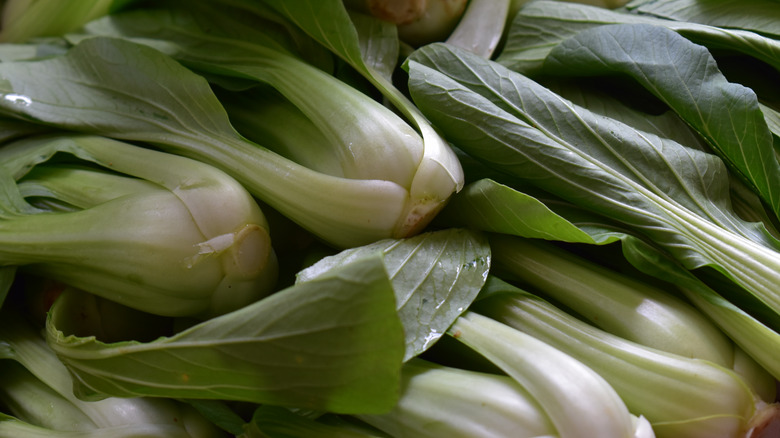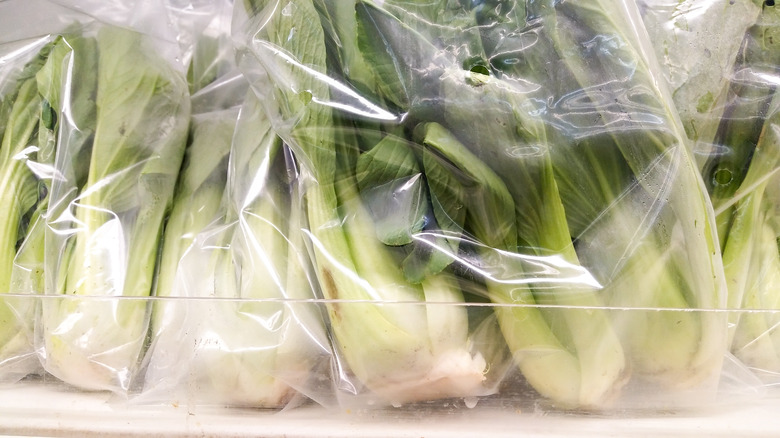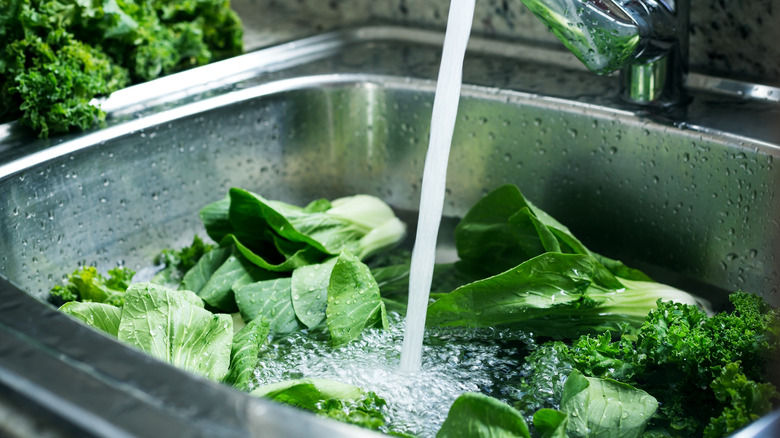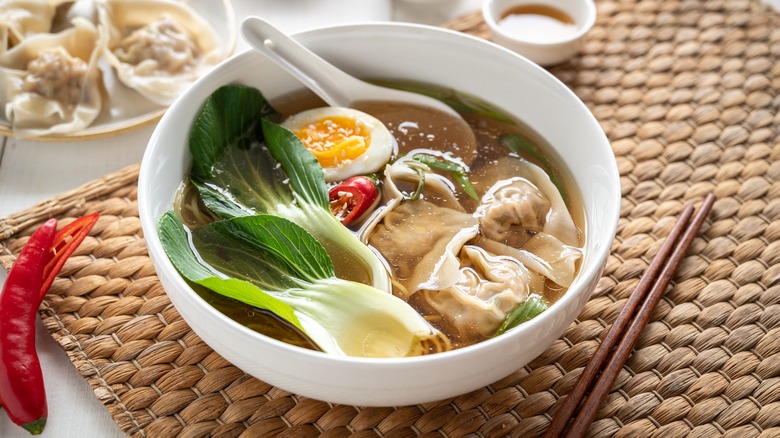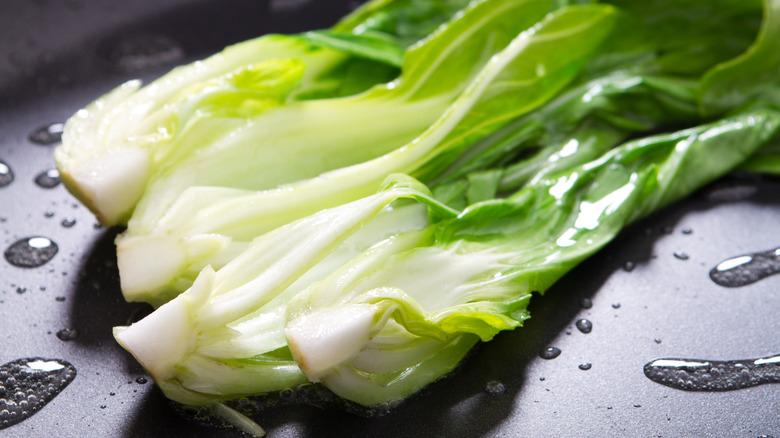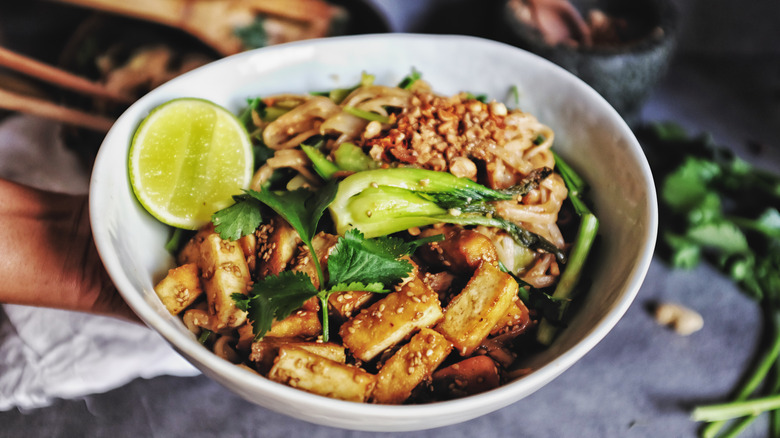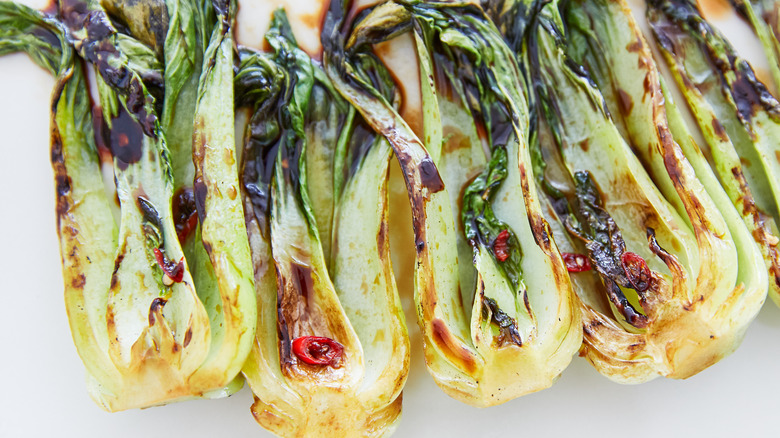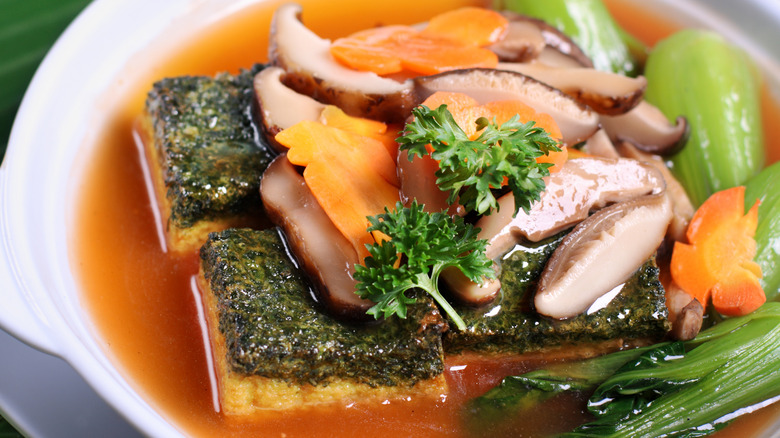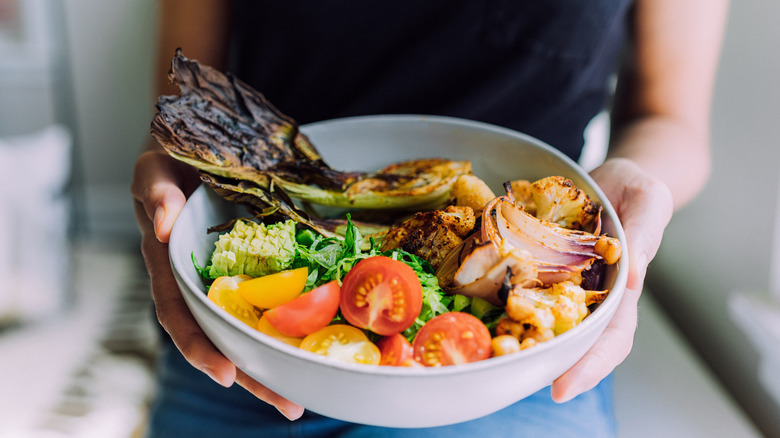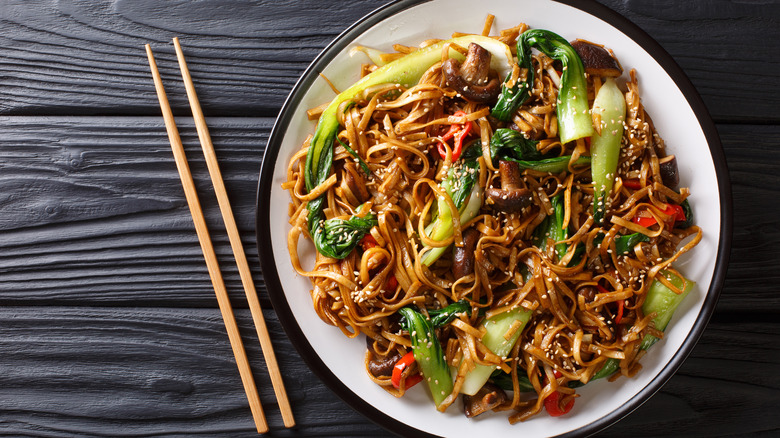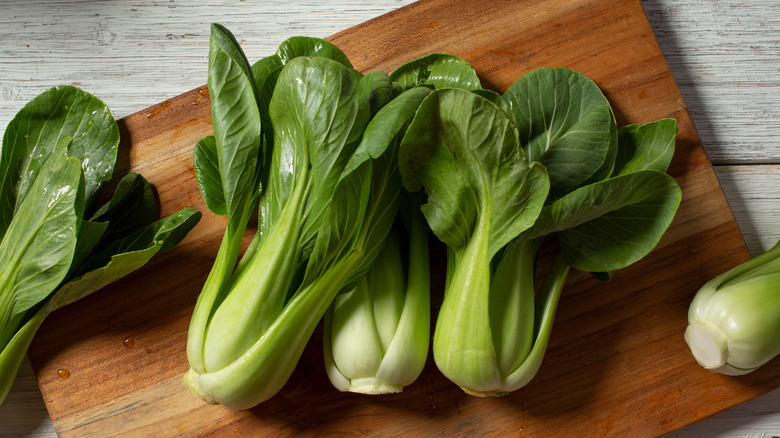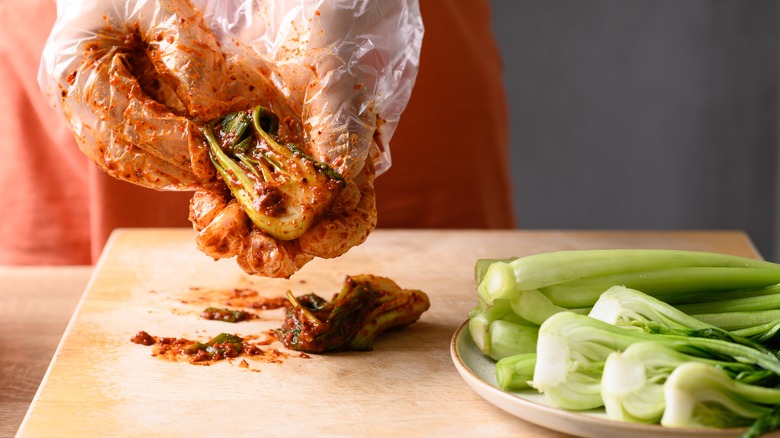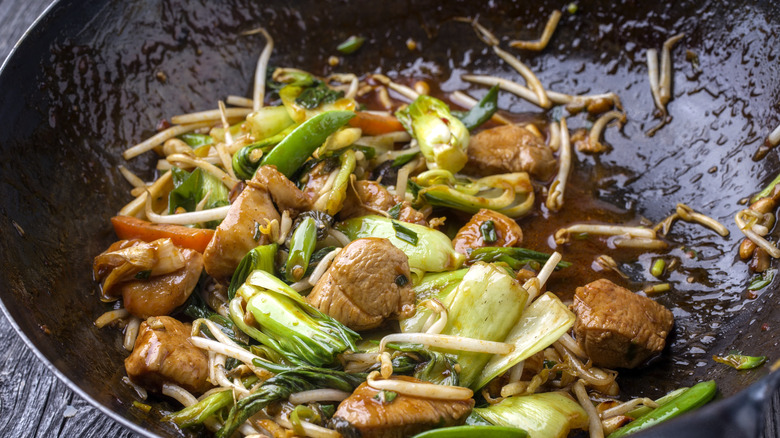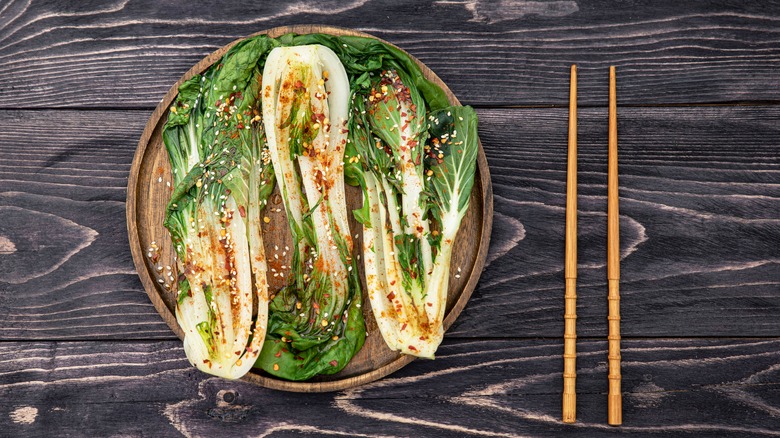Tips You Need When Cooking With Bok Choy
Although kale has been deemed the trendiest leafy green in modern-day America, plenty of other veggies deserve a day in the spotlight. Bok choy, also known as pak choi, is a Chinese variety of cabbage that can be readily found in almost any grocery store.
Why do we suggest adding this leafy green to your plate? Cruciferous vegetables are loaded with fiber and micronutrients that aid in reducing inflammation, boosting immunity, and supporting longevity. In fact, studies indicate that bok choy supports bone and thyroid health and may have anti-cancer properties (via Asian Pacific Journal of Cancer Prevention). In addition, chefs love to cook with this leafy green because it soaks up flavors nicely, and although it is most popularly used in ramen, it can be cooked using several methods and added to a spectrum of dishes.
Although it can be slightly bitter when eaten raw, this vegetable makes the perfect addition to any savory dish and can be used in various ways. Just follow these tips when cooking with bok choy, and broaden your culinary horizons.
Choose the right variety
Black summer bok choy is the most common variety and will typically be available in your local grocery store or farm stand. On occasion, you may spot mei qing choi, which is a flatter, more compact variety, and joi choi, which is softer with dark green leaves and a bright white stalk (via Tips Bulletin). In the end, the only choice you'll have to make is likely between baby bok choy, which is about the size of your hand, and large bok choy, which often weighs around one and a half pounds. Both are viable options, but keep in mind that the smaller vegetable is often cooked whole or halved, while the bigger plant is chopped or diced.
It's also important to choose healthy bok choy, which will have sturdy leaves and a crisp white or light green stalk without blemishes. The stalks should not feel rubbery but crisp and firm with just a little give, as described by the Chefin. Much like leeks or celery, this cruciferous vegetable collects dirt at the base where the stalks connect, but don't let that be a deciding factor when selecting your bunch.
Store it properly
How many wilted vegetables are sitting at the back of your refrigerator, hoping to be chosen as you grab that frozen pizza? No shame! But there are a few methods to ensure your bok choy will last longer, and trust us, once you try it, you'll never forget about it again.
Like many leafy greens, it's important to reduce the amount of moisture buildup to prevent rot. Wait to wash your bok choy until you're ready to use it, and store it in an unsealed bag to promote airflow. Try cutting slits in the side of a ziplock baggie and storing the veggie in the crisper for up to four days (via Home Stratosphere). For washed stalks and leaves, pat them dry or even wrap them in a paper towel before returning them to the refrigerator. You can even set full stalks in a shallow jar of water and store them in the fridge for extended shelf life.
Already let your bok choy wilt? No problem. Simply soak your leaves in ice water, pat them dry, and return to the refrigerator to zap a little life into them.
Wash it thoroughly
If you frequently enjoy leeks, you may understand the absolute struggle of getting each grain of dirt out from in between the plant's layers. Unfortunately, bok choy shares a similar structure, so it's incredibly important to be sure it's thoroughly washed so you don't crunch into a mouthful of dirt. Luckily, this vegetable is a bit easier to clean, and there are a few methods to ensure smooth sailing, as described by Food Roots.
Firstly, if you'd like to keep an intact stalk joined at the base, fill a sink or large bowl with cold water. Agitate the water and gently pry the stalks from the bottom without snapping them. If you have a sprayer mechanism on your sink, use it to flush out any dirt between the layers. Continue this process until you can no longer detect any particles, and then rinse the cluster once more with the sprayer or a clean bowl of cold water.
If you plan to slice and dice the head, do so before washing. This will give you access to those nooks and crannies, so take advantage! If you're chopping off the whole head, consider using a salad spinner to soak, drain, and spin the leaves a few times through.
Cut it, or don't
It is common practice to cook whole baby bok choy heads, so there is no need to question which parts of bok choy you can eat –- it's all delicious. If the roots are still attached, consider slicing them off without cutting too far up the stalks to keep the base intact. If you plan to cook whole leaves and stalks unattached, trim the plant about half an inch from the bottom to separate the stalks. Think of this like cutting celery ribs from their base.
For larger varieties, consider entertaining a few tried-and-true methods. For stir-fries, fried rice, soups, and noodle dishes, first cut the stalk away from the stem using a sharp knife. Dice the stem separately from the leaves, and toss them in the pan or steamer first to give them a head start before adding the rest (via Cook's Illustrated).
For grilling and roasting, it's often suggested that whole bok choy heads are sliced down the center from top to tip to reveal each layer. These little pockets will hold sauces and spices nicely, and the folds will crisp up at high heat.
Steam it for a nutritious boost
If health is a concern of yours, it's time to embrace steaming. This oil-free ancient method can intensify nutritional properties in some vegetables, including leafy greens like bok choy. Because steaming does not require oil or salt, it's considered the "cleanest" way to cook, along with boiling. By breaking down the outer layers and the cellular structures with heat, our bodies can absorb the nutrients more easily, boosting levels of beta-carotene and other antioxidants faster (via CNN).
If you plan on leaving baby bok choy intact, as you might for a ramen dish, consider cooking the whole head directly in the soup. Otherwise, use a steamer basket, microwave steamer, or sautee pan with a lid and ¼ inch of water to soften the cruciferous vegetable. Cook the bok choy until the stem softens and the leaves turn a deeper shade of green. Keep in mind that foods continue to cook slightly even after being removed from heat, so consider removing the bok choy prematurely from the pot or pan to ensure perfectly steamed veggies.
Use it to enhance stir-fry
There's a reason bok choy is most popularly known for its stir-fry abilities. While the stem adds a refreshing crunch, the leaves absorb sauce and flavor. This leafy green beats out spinach in the stir-fry category because of its tough structure and unique flavor profile. Consider using a wok to elevate your stir-fry game. High-heat cooking creates crispy yet tender veggies, and the bowl-like shape of the pan allows for instrument-free stirring. Simply grab the wok's handle and flip your food around like a pro. This also prevents the bruising of tender vegetables like bok choy.
Andrew Zimmern suggests a few crucial tips when cooking with a wok. First, it's important to heat the empty pan until it begins to smoke before adding a high-heat oil like grapeseed or peanut oil. After the oil is piping hot, it's time to add your vegetables and proteins of choice. Keep the wok at a high temperature throughout cooking, and toss the ingredients frequently to enjoy delicately cooked and seared dishes. Consider adding the sliced-up stalk before incorporating the tender leaves.
Stir-fried bok choy recipes often include other Asian vegetables and proteins like tofu and a soy-based sauce. Remember that because bok choy holds a mild flavor, it can complement almost any stir-fried dish.
Grill it in halves for a beautifully layered dish
Bok choy is beautiful with its bulbous base and white veins contrasting with the deep green shade of its leaves. Let's take advantage of that! When cut in half from top to bottom, many layers are revealed. These layers, pockets, and folds do an incredible job hosting sauces, juices, and rubs while crisping up nicely on the grill. The finished product is not only power-packed with flavor but is also beautiful to look at. This trendy presentation will be sure to impress guests, so keep this grilled bok choy recipe in your back pocket during barbeque season.
Simply slice whole heads of either baby bok choy or a medium variety of bok choy in half, top to base. Rinse the pieces thoroughly, and lightly brush them with your sauce of choice. Want to keep it simple? Mix a little tamari and sesame oil to enhance the flavors and texture of your new favorite leafy green.
Place the bok choy cut-side-down on the grill, and keep an eye on those leaves. They might begin to burn if they haven't been doused in sauce. If this is the case, consider grilling with wood planks to create a barrier between your veggie and the open flame.
Braise it to absorb more flavor
Bok choy is similar to tofu. Hear us out -– it's a mild-flavored vehicle for sauce, much like chicken, tempeh, and romaine lettuce. As hinted before, because of its cellular structure, bok choy absorbs spices and flavors beautifully once cooked. In fact, it makes a fantastic candidate for braising because it's given plenty of time to stew slowly and take on the flavors around it.
While bok choy can be the featured item in your meal, it can also make a beautiful side dish, braised in the juices of pork belly, short ribs, or chicken. Use pre-washed, whole baby bok choy. Add your oil, liquids, or aromatics to the hot pan before adding bok choy (via Kitchen Accomplice). It's recommended that you add the tender leafy green for no more than 10 minutes before you remove the pan from the heat.
Dark greens contain quite a bit of calcium, and cooking them releases it for easier absorption, along with critical antioxidants like lutein for eye health and beta carotene, per Michigan State University. Opt for braising for higher rates of nutrient absorption and flavor retention.
Roast it for a crispy, soft, side dish
Leafy greens and tender vegetables hold up well when cooked at high heat for short periods. Their structure can stay intact without becoming mushy, while the outer layers and skins crisp nicely. Bok choy is no exception.
Minimalist Baker recommends cooking vegetables at 400 degrees. Preheating the oven is pertinent, as slow-cooked vegetables can often overly soften and lose their tenderness. Additionally, bok choy does not take long to cook, as it is not very dense.
Roast cut or whole bok choy on high heat after seasoning it with sauces, spices, and oil. Keep in mind that adding too much moisture, like a thick and heavy barbeque sauce, may keep your cruciferous vegetable from reaching its full potential. Going lighter will ensure the bok choy softens on the inside and crisps up on the outside. Keep an eye on your leaves to ensure they don't burn, although it's okay if they begin to brown.
Use the leaves for salads and soups
If you enjoy a mildly bitter flavor, try bok choy leaf salads. Often best when mixed with less bitter leafy greens like massaged kale, arugula, bib, or romaine lettuce, this vegetable offers a variety of textures and flavors. Like many dark greens, bok choy can be enjoyed cooked or raw, so they are perfect for warm salads. In addition, you should try "killing" your next salad containing bok choy with hot grease or cooked fat because it enhances the flavor and holds up nicely under heat.
When cutting the dark green portion of bok choy for stir-fries, consider rolling it into a tube and then slicing across it to produce long, ¼-inch wide stands. These will cook down quite a bit, so don't be concerned with the length, per Misen. These leaves can be added to almost any savory dish and cook beautifully in soups.
Don't forget to use the stem
Unfortunately, it is standard practice in some households to toss vegetable stems when in fact, they have dozens of uses and often contain quite a bit of nutrients. For instance, there are many ways to use up your leftover kale stems that might otherwise go head-first into the compost bin, or even cabbage stems that are often tossed when they could be roasted and enjoyed. Luckily for bok choy, their stems are desirable and often the featured element of the plant.
While the entire leaf can be eaten, this is often the part of the plant that wilts first. If you can't perk the leaves up using ice water, simply use a sharp knife to cut the stem off. You can either cut it lengthwise or down the middle, according to Misen. The stems can be cooked on their own, added to stir-fries, or even air fried. Although slightly bitter, they can also be finely diced and added raw to salads for a bit of crunch.
Substitute it for cabbage in kimchi recipes
Ever heard of sauerkraut's spicy neighbor, kimchi? This fermented delicacy often accompanies Asian dishes and is typically made with Nappa cabbage, a close relative of bok choy. As it turns out, bok choy makes for a great substitute, although there are differences between the two vegetables. Bok choy has a slightly stronger flavor and has heartier stems and leaves. This means that while fermenting, the cellular structure may take a little longer to break down and absorb the vinegar.
When prepping your classic homemade kimchi recipe, simply use the same quantity of finely cut bok choy instead of the called-for Nappa cabbage. For vegan kimchi, omit the fish sauce and replace it with tamari or coconut aminos. It's important to keep in mind that there are many different types of kimchi, so consider choosing a recipe that best matches your flavor profile. Some variants can be quite spicy, while others contain quite a bit of salt.
Experiment with flavors for unique meals
As you have learned by now, bok choy is quite mild in taste, so it's no wonder that culinary creatives enjoy using this veggie as a vehicle for the sauce, herbs, and other seasonings. While this leafy green holds up most famously with Asian spices, it also pairs nicely with flavors from around the world. Try cooking your bok choy in a little sesame oil and tamari or soy sauce for a simple yet reliable favorite. Add a splash of balsamic vinegar, lime juice, or maple syrup for added flavor. In addition, hot pepper flakes are always a good choice when you're ready to turn up the heat.
When it's time to bring it to the next level and create your own flavors, consider following FASS, an acronym that helps cooks develop a balanced flavor. Chef Rebecca Katz explains that this stands for fat, acid, salt, and sweet. Each sauce and dish you create should contain an element from each. For instance, olive oil (F), lemon juice (A), mustard (S), and maple syrup (S) work together to create a complete flavor profile for any marinade, dressing, or sauce.
The options are endless, from miso sabayon marinades to pomegranate molasses barbeque sauce recipes. Roll up your sleeves, grab some bok choy, and get cooking!
Try using a dry rub
Bok choy, like many vegetables, contains quite a bit of moisture. If you're looking for some crispy layers, wet sauces might not get you there in the brief time it takes to cook leafy greens. Dry rubs aren't just for meat: Consider using them to spice up your bok choy on the grill or in the oven.
Simply create a balanced dry rub which, according to Meathead's Amazingribs.com, should contain elements of salty, sweet, savory, spicy, and spices and herbs to be complete. All these targets can be hit with even a three-ingredient dry rub recipe. Lightly oil your halved bok choy with a high-heat oil, and rub the veggie with your dry spice mix. Try to get the seasoning in all nooks and crannies, all the way up to the tops of the leaves.
Place your bok choy with the cut end facing the heat source: For the grill, place it cut-side-down, and for the oven, place it cut-side-up and close to the heat. Keep an eye on the thin leaves, and enjoy flavorful, crispy bok choy when done.
